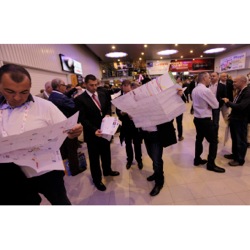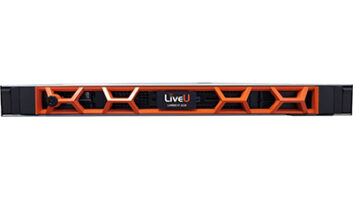
The 4K experts
+ Chris Forrester, TVBEurope contributor and moderator
+ Oleg Kolesnikov, CTO at Russian pay-TV broadcaster NTV+
+ Jerome Vieron, Advanced Research manager, Ateme
+ John Adam, head of business development at Samsung
+ Ludovic Noblet, senior director Technology, Strategy & Planning, Dolby Labs
+ Michel Chabrol, director 3D & Ultra HD, Eutelsat
+ Massimo Bertolotti, head of Engineering and Innovation, Sky Italia
4K for TV (3840×2160 pixels) was visible just about everywhere at IBC in Amsterdam and by common agreement the broadcasting industry is at a tipping point as it prepares to migrate from yesterday’s HDTV to tomorrow’s 4K. And Paris-based Eutelsat is wholly ready for that transition. Indeed, it already has deals in place with VIP players such as Samsung to provide a demo UHD channel that’s beamed into Samsung shops and electrical retailers to provide ‘wow’ at the point of sale.
Eutelsat organised a panel of experts at IBC to address the many challenges still to be resolved in terms of end-to-end 4K transmission, and its first speaker shocked the audience by revealing that the upcoming Sochi Winter Olympic Games would be captured in 4K, if only for cinema and public area viewing and as part of a technology test.
Oleg Kolesnikov, CTO at Russia’s pay-TV broadcaster NTV Plus, said: “We tested 4K in July in partnership with Russia’s largest production company, Panorama HD. The Olympics in Sochi could represent a strong platform for demonstrating its potential.
“Our tests used the H.264 mosaic cluster of four images using Canon cameras and Ericsson encoders, and using Eutelsat satellites. As an intermediate solution this works but we need to move forward so that the complete image is encoded in one go. We have planned for other tests this autumn, but using HEVC technology.”
Kolesnikov added that beaming the content to some cinemas and other public viewing points was the initial target in order to showcase the technology. However, he admitted that NTV+ wanted to get away from the 100Mb of bandwidth needed for the mosaic of four streams and quickly move to HEVC encoding and a single, more efficient stream.
“In the long term we definitely need the encoding to cover the complete picture in one stream. Currently the risk is that the thin line that [bisects] the four images could be visible. The fact is that currently each of the four encoders knows nothing about its adjacent encoder and from my perspective we need more co-operation from the [encoder] vendors so that by October this year we can again run tests by encoding a complete image and using HEVC technology.”
New 4K adventure
The next panellist was Jerome Vieron from compression specialist Ateme, and by common consensus the whole of the broadcasting value chain is waiting for such companies to start manufacturing encoders incorporating the crucial HEVC-enabled chips-sets.
Vieron said Ateme is working hard on the complete video compression task and was well advanced with plans to deliver professional encoder units to clients. This included 4K and even 8K encoding solutions, working with Japan’s NHK on its ‘Super Hi-Vision’ project.
“We are very busy with this new 4K adventure for Europe, and have supplied the equipment to Eutelsat to enable its UHD channels to be carried, albeit in H.264. Our R&D work at Ateme is to make the very best solution for UHD and this includes HEVC but that requires us to bring something new to the view, which is a totally immersive experience in terms of the video. It is not just more pixels. We are taking part in the French 4EVER project [looking at many of the production and post production tasks related to UHD] and this includes working with DoReMi, Technicolor, France Televisions, Globecast and Orange.
“Our job is to study Ultra HD and HEVC. I admit we have difficulties because at the moment the market is not very clear. For us and our competitors we are probably only just at the starting block. So far we do not know what the market wants.”
Vieron said he anticipated a strong demand for suitable equipment from telcos, themselves keen to squeeze higher quality through their existing wires and cables. The cellular industry would also benefit from HEVC encoding. “One market is definitely the OTT sector.”
Samsung’s John Adam agreed that IBC2013 was a 4K show. “The August IFA show in Berlin was also very much a 4K event. However, we also need to be realistic and say there are still gaps that need to be filled.
“There are certainly discussions about the connectivity with the set-top box, and we have to solve copy-protection issues, and there’s considerable discussion with Hollywood about that aspect. But looking forward we are seeing broadcasters in Europe, North America and Asia who are gearing up for UHD. The Digital Europe consortium of all the main consumer electronics manufacturers is looking at how best to communicate to viewers the benefits of UHD.
“Indeed, the 4K train left the station at CES in January 2013. The industry is now awash with 4K displays, and it is only going to get better. The market will become more defined and the connectivity issues solved. For sure, the consumer electronics industry will be ready the moment the broadcaster industry is ready.”
Asked how important key televisual events such as the FIFA World Cup in 2014 and the Rio Olympic Games might be in capturing public enthusiasm for UHD, Adam said that in terms of TV any major global event was a catalyst for consumer purchasing of new displays. “We know this always happens. When we look at the 2016 Olympics that will be a very sweet spot for the industry and will undoubtedly be a trigger point at retail and it could be a very good timing from the broadcasters’ point of view.”
Investment monetisation
Ludovic Noblet, Dolby Labs’ senior director Technology, Strategy & Planning, says Dolby is ready for the new transmission format. “We last had to do this when HDTV was introduced 10 years ago, which itself followed on from the digitisation of TV.
“Viewers were looking for better quality, and now we see the world looking again at something different. UHD is but one part of this ‘next generation’ and we see it providing greater immersion, with which our Surround Sound products have always helped. But it might also encourage more interactivity via second screens and tablets, and content flowing from one device to another.
“It is definitely not just about more pixels, but better pixels and better sound. One of Ray Dolby’s [who passed away the day before this meeting] repeated messages to all of us was ‘no nonsense between content creation and content consumption’. This still makes total sense. These new technologies will allow content creators and broadcasters to re-visit the art and craft of their work. This includes games and other audiovisual entertainment.”
Michel Chabrol, who looks after Eutelsat’s digital cinema activity as well as its 3D and UHD projects, says that 4K is of “strategic importance” to Eutelsat. In January 2013 they created their first 4K demo channel showing not only that satellite was the natural home for UHD “but that it would work on satellite”.
Chabrol said Eutelsat was in the centre of a virtuous circle with producers clearly wanting to see UHD on air as soon as possible. “Production companies making 4K programming would progressively be looking to see their material broadcast, and they will look to the pay-TV bouquet operators to help monetise their investments in UHD.
“They are of key importance in the value chain, and we sit in the middle of this. We totally believe in the process. Initially we are transmitting in MPEG4, but very soon we see the switch happening with HEVC taking over and broadcasters getting the benefit from the new compression technology. We think it is a great moment in time, where a new transmission system comes about with obvious benefits and is enabled by the new HEVC encoding format.”
Sky Italia head of engineering and innovation Massimo Bertolotti stressed that its 3D transmissions were far from over, and there remained a good revenue stream. “Our approach is to continue to invest in technology and innovation.” Nevertheless, Sky-I was looking ahead to 4K, and test transmissions.
However, he cautioned the potential for confusion with the different terms (4K, Ultra-HDTV) which, he said, might not be good for the consumer. “We need to stress all the key elements, including higher frame rates, higher dynamic range and so forth but none of this means much to the customer. So, for us, we want to start targeting what UHD really offers.
“We at Sky see 4K as the new viewing experience. Starting from this point, we decided to start concentrating on shooting and the contribution side of live events. The second area we looked at was the managing of that content and delivery to the customer.
“Today the system isn’t stable, because all of us are cutting and pasting existing technology and we have yet to see a complete 4K eco-system. We will continue to test and experiment. We are thinking to do some tests during the FIFA World Cup with Sony for next year, but I am not sure the full chain will be in place for the soccer.”
Bertolotti told colleagues to remember the launch of HDTV and that happened when 95% of the technology was in place. “Now we have a great deal to do, and it also comes down to things we thought we understood, such as the positioning of the camera and how the cameras are used and perhaps different standards for some of those cameras. In fact I would be surprised if we completely adopt 4K for every camera at a sports event. Almost certainly there will be a mix.”
Bertolotti agreed that increasing frame rates in UHD was a key target, in order to avoid motion blur. “We have to mitigate the artefacts that come with UHD and a slow frame rate. We are generally moving toward 60fps although 60fps is not enough for the new technology. We need more experiment using the cameras, and how best to handle fast-moving sport. Today, 60fps is the best we can get, but we need more.”
NTV’s Kolesnikov agreed that higher frame rates were key. “We are doing a great deal in terms of sports production, and the higher the frame rate the better it looks. HDMI’s current Version 1.4 specification limits us to 30fps, but higher definition demands higher frame rates. And challenges like super slow-motion for UHD need to be remembered.”
Kolesnikov said he had seen some super slow-motion cameras at IBC capable of handling up to 900fps, and these pointed the way to the future.
Samsung’s John Adam told delegates that the Digital Europe consortium was looking closely at frame rates, and how the display industry would be ready for broadcasters. “The base line, at least for the short to medium term, would be 50-60fps. This is what the mass-market can expect and what we will support.
“Over time that may evolve and some high-end manufacturers will support improved frame rates and we at Samsung will continue to innovate and improve. But what the whole industry faces is the cost of these advanced features and at the same time trying to satisfy consumers and broadcasters who ask ‘when will prices come down’?”
The $64,000 question for each of the panellists was ‘when?’ And most of them politely ducked giving any sort of tangible answer. Eutelsat stressed it was ready to start at any time. Sky Italia said there was still much work to be done, more content was needed and there was a heavy need for encoding equipment. John Adam said that while the display manufacturers could supply UHD material with each set purchased there wasn’t likely to be Blu-Ray 4K players or content much before 2015.
Adam said for the first time UHD represented a global market and opportunity. “I do not share the view that Europe is way ahead of the rest of the world. We know of the plans for South Korea to launch 4K next year.
“There are other markets looking closely at 4K. But don’t forget user-generated content. There are 4K prosumer camcorders out there now.
“I think there are many peripheral reasons, other than broadcasting, why people will buy UHD displays. But by the time of the Rio Olympics I think all the boxes that need to be ticked to see widespread adoption of UHD will be in place — right across the eco-system.”
By Chris Forrester
www.ateme.com
www.dolby.com
www.eutelsat.com
www.ntvplus.com
www.samsung.com
www.sky.it







